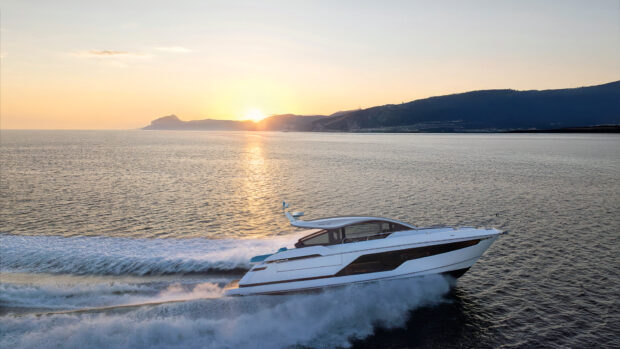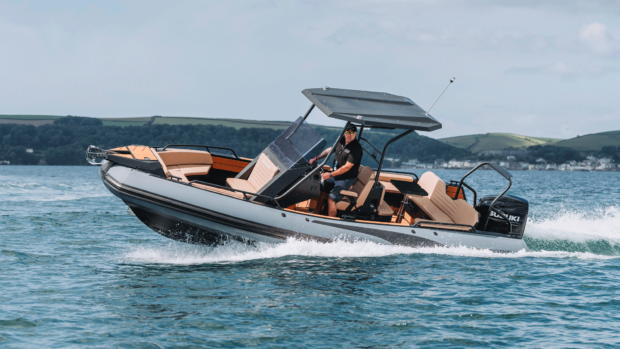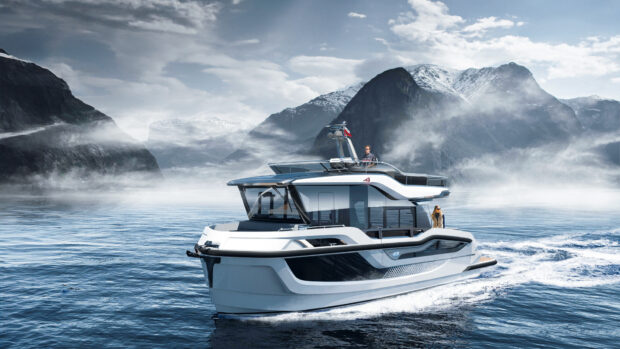Life in paradise comes at a price for the crew of Egret
Position: S17 30.24 W49 49.25 2 Cook’s Bay, Moorea, French Polynesia
Scott (YT) and Mary Flanders (MS) left Gibraltar on 16 September 2006, and we’ll be following their journey every step of the way, thanks to this unique online “blog”. For a complete list of all the couple’s blog entries click here
Life in paradise comes at a price for the crew ofEgret
Tuesday 24 June
Well, mis amigos, the routine is killing us. It’s up early morning to start the generator, then turn on the watermaker, make a pot of just-ground Starbucks French roast, put a load in the washer if necessary, deliver a fresh cuppa to my sweetie (in bed) and head to the flybridge. Soon afterwards I hear her rings clinking on the stainless steel rail as she makes her way up to the flybridge, not wanting to miss the sights. This morning she brought the whole pot for refills. It is cool on these early mornings.
The surf break along the offshore barrier reef is like watching a surfing movie that never ends. It builds high, the wind blows the tops off the waves then it crashes down on the reef and shortly afterwards it repeats itself. Next it is time for Mary to make breakfast while I spend a little time pounding out these posts. Breakfast, boat chores, visiting cruising buddies, meeting new cruisers, shopping, and then time for retreating to the flybridge for a glass of wine or whatever. Yup, the surf’s still breaking, it’s cool again. Friends may or may not be over, then we have dinner, sometimes watch a movie, sometimes read a book and then it’s off to bed.
Another day shot and what have we done? Exactly what we want because we’re free. Freedom however, comes at a price – # %$&^*! inverter gets drowned, # %$&^*! Whale-type fittings leak, # %$&^*! fresh water pump quits and so on. The good news is that these things don’t happen every day so in the grand scheme of things it’s a small price to pay for freedom.
Today’s chores are lowering the catamaran dink and cleaning up the old dinghy chock sealant and mixing paint to blend in with its epoxy patch (yesterday we very carefully positioned the dink and marked where the chocks are to be mounted for the dink’s new location on the boat deck). After the paint dries we’ll drill and tap the boat deck for the chocks in their new location, apply sealant, then bolt them down. Mary’s job will to deflateEgret’ssix large inflatable fenders and stow them away. We won’t need fenders again until we refuel in American Samoa. Also today we’ll inflate our antique inflatable dinghy and set it on our new found space on the boat deck. We looked into replacing the 8hp Yamaha we lost in Easter Island while in Tahiti but the local dealer wanted 40% more than what we paid before so we’ll wait for New Zealand’s friendlier pricing.
We mentioned before the anchorage has an abundance of American boats. Close toEgretare boats from: South Africa, Mozambique, UK, Switzerland, Germany, Belgium, Holland, Netherlands, Sweden, Denmark, France, Poland, Canada, Australia, New Zealand and Chile. Quite an international community. A number of boats we have talked to are following the same basic itinerary as us. We hope to be able to get away from the crowds in the northern Tongan group of islands. This group is largely unchanged and yet to be overwhelmed by foreign investment. All this said, we are easily led by other cruisers’ tales so it will be interesting to see where we have actually been by the time we arrive in New Zealand.
We are currently anchored near a shallow, circular reef. When the wind swings to a N’ly or NW’ly direction we are close to the edge but still in 61ft of water. The anchorage is full on both sides of the channel. All day long arriving boats have been heading for the ‘big hole’ in the anchorage. Fortunately either ourselves or a nearby sailboat from Denmark give a shout and off they go. Yesterday a steel ketch from Poland went over the reef and miraculously didn’t hit it. It must have been a swing keelboat with the keel raised.
The water is clear, the reef sand reflects light green and the shallower coral is yellowish but in low light or when motoring into the sun without driving from a flybridge you can’t see the bottom (that leaves out every other boat in the anchorage except N50Flat Earthwhen they were here andEgretIt’s funny, I’m writing about anchoring and just minutes ago an American ketch dropped its anchor between us and our anchor. We didn’t say anything until we saw how things played out.
We have the paravane arm lowered on the starboard side (their side) for raising and lowering the dink easier. We could see some heads swivelling, looking at the snagging paravane arm, the reef, and there was lots of hand waving from the bow to the cockpit. In the end they pulled the hook and reset it, avoiding snagging our chain. Now it’s the Denmark’s boat problem and they’ve dropped close behind their boat. Life in the big city.
The wind puffed all day yesterday so we stayed put except for a short visit to a Swedish friend’s boat to kidnap them and bring them back toEgretfor sundowners. This morning it was calm so we set off early for the 18nm trek to the other side of Moorea. After a straight forward entrance through the barrier reef we are now anchored in Cooks Bay, named after Captain James Cook who was close to here in early June, 1769.
The scenery is spectacular and has been drawn and photographed countless times. Some years ago we saw a picture of Bruce and Joan Kessler’s trawlerZopilote(the first American trawler circumnavigators), in either Cooks Bay, Moorea or in Bora Bora, which inspired us. This simple picture helped set the wheels turning. Fifteen years later here we are.
Picture 1. What a couple of Swedes wouldn’t do for a glass of flybridge wine
Picture 2. Entrance to Cooks Bay, Moorea










